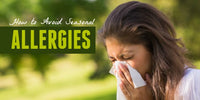
Here's Exactly How to Avoid Seasonal Allergies
, by Hi-Health, 5 min reading time

, by Hi-Health, 5 min reading time

If you’re one of the nearly one in three American adults who suffers from hay fever, you know the symptoms all too well: itchy eyes, runny nose, and sneezes (lots of sneezes). Over-the-counter and prescription medications can bring relief, but also cause unwanted side effects, such as sleepiness and anxiety.
This year, don’t wait until peak allergy season to fight back against that mountain of wadded tissues. Experts say allergies can work like a “drop in the bucket,” where repeated exposures to various allergens add up gradually until the immune system “overflows,” or rather overreacts, flooding the body with inflammatory histamine compounds that are behind those pesky sneezes. It’s impossible to manage every environmental allergen, says Stephanie Becker, ND, of the Washington Center for Complementary Medicine in Washington, D.C. “But we can clean up a large percentage of other allergies you respond to, eliminating or reducing the severity and frequency of seasonal allergy symptoms.”
The key: Start now to give natural remedies a chance to take effect. By reducing your exposure to allergy triggers— and by boosting your immune system—these diet, supplement, and environmental tips can stall allergy attacks, even when pollen counts soar.
Although seasonal allergies may seem unrelated to food allergies and intolerance, they provoke similar responses in the body, taxing the immune system. “Eighty percent of our immune system is in our gut,” says Michael Smith, ND, a naturopathic physician at Carolinas Natural Health Center in Charlotte, North Carolina. Most people unwittingly eat foods every day that may trigger a food intolerance for them, he says. “If we can remove those reactions and lower the body’s total immune system activity, we can help prevent people from going over their allergic threshold.”
Unlike immediate or immunoglobulin E (IgE) food allergies, which cause immediate, more obvious reactions, delayed food or immunoglobulin G (IgG) allergies—also known as food intolerance—may not surface for hours or days and can cause less severe symptoms like wheezing, coughing, nasal congestion, skin rash, or digestive change. Because many people never associate these warning signs with the foods they eat, they don’t realize the burden they’re placing on their immune system, Smith says.
Common IgG culprits include dairy, wheat, corn, soy, yeast, and nuts. Ironically, it’s often the foods a person craves the most that cause trouble. Some experts speculate that allergic responses increase brain serotonin or dopamine levels. “This feeds our craving,” Smith says. If you suspect a food intolerance, consider asking your health care practitioner for a blood test, or better yet, try a food-elimination diet. Remove common offenders (see above) from your plate for a couple of weeks, and then gradually reintroduce them one by one over several weeks, watching for any ill effects, says Smith.
Before allergy season gets going, stock up on colorful fruits and veggies such as red onions, capers, and apples; they’re rich sources of biofavonoid compounds like quercetin and catechins, which have been shown to block histamine release, says Ed Bauman, PhD, founder of Bauman College Holistic Nutrition and Culinary Arts. And drink lots of green and black tea; both are packed with allergy-preventing biofavonoids. At the same time, go easy on saturated fats and cholesterol. Diets rich in butter and cholesterol are associated with greater frequency of wheezing and hay fever in children, although the reason is still not known. Bauman also recommends buying and keeping organic produce fresh; it can develop mold and bacteria faster than conventionally raised produce because it isn’t fumigated or exposed to chemical preservatives.
Allergic reactions happen when your natural defense mechanisms malfunction, so now is the time to tune up and balance your immune system, says Becker. Commit to frequent sessions of moderate exercise and other stress relieving activities, which can help boost immune response. And try to stick to a regular sleep routine to help keep adrenal glands, which secrete the “stress hormone” cortisol, on a normal cycle. When the adrenal glands are stressed they produce too much cortisol, wreaking havoc on the immune system; healthy amounts of cortisol have an anti inflammatory effect that reduces histamine secretion, Becker says.
To minimize common allergens such as dust mites, pet dander, and chemicals, get on a frequent vacuuming, dusting, and pet grooming schedule. But avoid cleaners and air fresheners that contain artificial fragrances; these airborne chemicals can work their way into your body and trigger immune responses, says Smith. For cleaner inside air, change your furnace’s air filter once a month during winter months. And consider buying a HEPA air filter for the bedroom, especially if you cuddle with your pet. Natural medicine experts agree that to kick allergies for good it’s crucial to maintain healthy diet and lifestyle habits and a supportive supplement regime even after hay-fever season. “The main thing is to find the root cause of the problem and solve it, not just for this allergy season, but next allergy season, too,” says Smith.
Quercetin: This biofavonoid compound effectively curbs histamines. “I put patients on this year-round,” says Stephanie Becker, ND. DOSE: 1,000 mg daily.
Bromelain: A pineapple derivative, this enzyme is known for its anti-inflammatory effects as well as its ability to soothe mucous membranes, the front lines of defense during allergy season. DOSE: 1,000 mg daily.
Vitamin C: This powerful antioxidant bolsters the immune system and helps protect cells from free radicals, debilitating molecules produced during infections and allergic reactions. DOSE: 2,000–3,000 mg twice daily.

BY: JOEL WARNER
Article from January/February 2016 Living Healthy Everyday Magazine. Download your copy here.


![PRōZE Review [2020 Update]](http://hihealth.com/cdn/shop/articles/cbd_insider_article_graphic_featured_image-11.jpg?v=1591495027)